Recent Storm Damage Posts
3 Reasons Why You Should Not Travel on Flooded Roads in Colorado Springs, CO
8/27/2024 (Permalink)
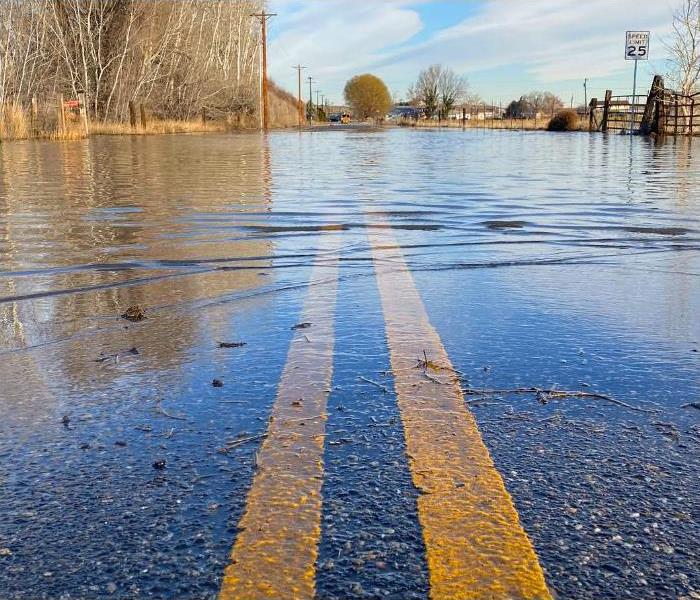 Flooded Roads in Colorado Spring,CO
Flooded Roads in Colorado Spring,CO
Flooding is a significant concern in Colorado Springs, particularly during the spring and summer when heavy rainfall can lead to flash floods. Despite warnings and advisories, many drivers still attempt to navigate flooded roads, often with dire consequences. While it might seem like a minor inconvenience to cross a flooded area, the dangers far outweigh the risks. Here are three compelling reasons why you should avoid traveling on flooded roads in Colorado Springs.
1. Unpredictable Water Depth and Force
One of the most dangerous aspects of driving through flooded roads is the unpredictability of water depth and force. What might appear as a shallow puddle can be much deeper than expected. Water is a powerful force, and even a few inches of swiftly moving water can sweep a vehicle off the road.
Deceptive Depth
In Colorado Springs, the terrain and road design can cause water to pool in ways that make it difficult to gauge its true depth. A road that seems to have just a few inches of water may have been compromised by the flood, with a washed-out section beneath the water’s surface. This makes it incredibly dangerous, as your vehicle could suddenly drop into a deep hole, leading to loss of control or becoming trapped.
Strong Currents
Floodwater isn’t just still water; it often flows rapidly, especially in the aftermath of heavy rainfall. In Colorado Springs, flash floods can create strong currents that are powerful enough to carry away vehicles. According to the Federal Emergency Management Agency (FEMA), it takes just 12 inches of rushing water to carry away a small car, and 18 to 24 inches can carry away most SUVs and trucks. Once your vehicle is swept away, you lose control, which can lead to severe accidents, injuries, or even death.
Underestimating the Risk
Many drivers underestimate the risk of driving through floodwaters, assuming that their vehicles can handle a bit of water. However, water can quickly disable your vehicle’s engine, leading to stalling in the middle of a flooded road. Once your vehicle is immobilized, you and your passengers are at the mercy of the floodwaters, which can rise rapidly.
2. Potential Vehicle Damage
Another critical reason to avoid driving through flooded roads is the potential for severe damage to your vehicle. Floodwaters can cause both immediate and long-term damage that may not be immediately apparent but can lead to costly repairs or even total vehicle loss.
Engine and Electrical System Damage
Water can easily enter your vehicle's engine, air intake, or exhaust system, causing the engine to stall and, in some cases, leading to irreversible damage. Water in the engine can result in hydrostatic lock, where the engine’s pistons cannot move, potentially causing the engine to seize. Additionally, floodwater can short-circuit the electrical system, leading to failures in essential components like the battery, starter, and alternator.
Contaminants and Corrosion
Floodwater isn’t just water; it often contains a mix of debris, mud, and potentially hazardous chemicals or sewage. When this contaminated water enters your vehicle, it can cause extensive damage to the interior, as well as to critical components like the brakes and fuel system. Over time, exposure to these contaminants can lead to corrosion, weakening the structural integrity of your vehicle and reducing its lifespan.
Transmission and Brake Damage
Water can also infiltrate the transmission and brake systems, leading to failure or reduced functionality. In automatic vehicles, water in the transmission can cause slipping or loss of power, while in manual vehicles, the clutch may fail to engage properly. Similarly, waterlogged brakes may lose their effectiveness, making it difficult to stop your vehicle in an emergency.
3. Increased Risk of Life-Threatening Situations
The most crucial reason to avoid driving on flooded roads in Colorado Springs is the increased risk of life-threatening situations. Flooded roads pose a danger not only to the driver and passengers but also to first responders who may need to conduct rescue operations.
Stranding and Drowning
One of the most significant risks of driving through floodwaters is becoming stranded. Once your vehicle is stuck, you may be unable to escape quickly, especially if the water is rising. Floodwaters can trap you inside your vehicle, and if the water reaches window level, it may be difficult or impossible to open the doors or windows to escape. In severe cases, this can lead to drowning.
Hazardous Debris
Floodwaters can carry debris such as rocks, branches, and other objects that can cause injury or further damage to your vehicle. These hazards are often hidden beneath the surface, making them difficult to spot until it’s too late. Striking debris can puncture tires, damage the undercarriage, or even shatter windows, putting you and your passengers at serious risk.
Overwhelmed Emergency Services
During a flood event, emergency services in Colorado Springs are often stretched thin, responding to multiple incidents simultaneously. By driving on flooded roads, you not only put yourself at risk but also potentially divert valuable resources away from other emergencies. If you become stranded or involved in an accident, emergency responders will have to risk their own lives to rescue you, which could have been avoided by simply staying off flooded roads.
Driving through flooded roads in Colorado Springs is never worth the risk. The unpredictable depth and force of the water, potential vehicle damage, and life-threatening situations make it clear that the safest option is to avoid flooded areas altogether. Instead, seek alternative routes, wait for the water to recede, or follow local advisories to ensure your safety and the safety of others. Remember, it only takes one wrong decision to turn a simple trip into a dangerous ordeal. When faced with flooded roads, it’s always better to turn around and find a safer path.
Mitigating Storm Damage: How SERVPRO Protects Colorado Springs, CO
7/4/2024 (Permalink)
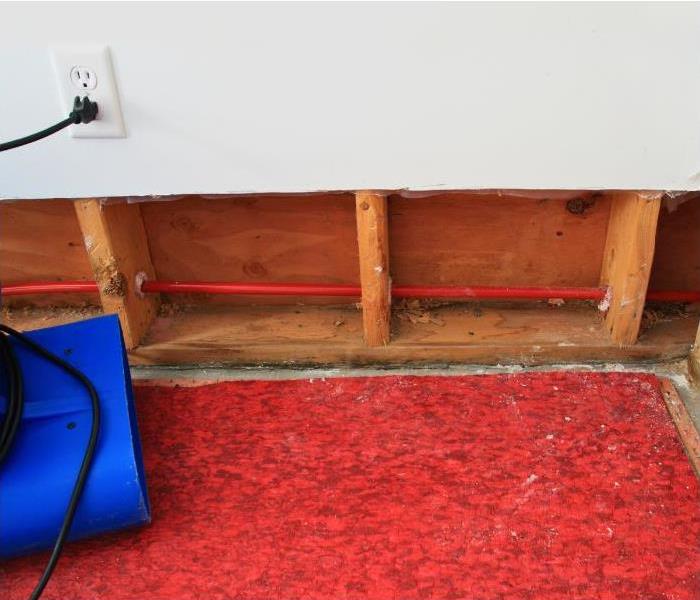 SERVPRO Protects Colorado Springs, CO
SERVPRO Protects Colorado Springs, CO
Colorado Springs, nestled at the foot of Pikes Peak and surrounded by picturesque mountains, is renowned for its stunning natural beauty. However, its geographic location also makes it vulnerable to severe weather events, including thunderstorms, hailstorms, and occasional blizzards. These storms can wreak havoc on homes and businesses, causing significant damage to properties and disrupting daily life.
In times of crisis, when storms strike and leave a trail of destruction, the residents of Colorado Springs turn to SERVPRO for assistance. SERVPRO, a trusted leader in the restoration industry, plays a crucial role in mitigating storm damage and helping the community recover swiftly. Let's explore how SERVPRO tackles storm damage in Colorado Springs, ensuring that homes and businesses can bounce back from adversity.
Rapid Response and Assessment
When a storm hits, time is of the essence. SERVPRO understands the urgency of the situation and operates on a 24/7 basis to provide immediate response and support. Their team of trained professionals promptly arrives on-site to assess the damage and devise a tailored plan for restoration.
The initial assessment phase is critical, as it allows SERVPRO experts to identify the extent of the damage, prioritize areas needing immediate attention, and outline the steps required to mitigate further loss. This proactive approach ensures that no time is wasted in beginning the restoration process, thereby minimizing disruption to the affected property owners.
Comprehensive Water Extraction and Drying
One of the most common issues following a storm in Colorado Springs is water damage. Heavy rains, flash floods, or burst pipes can lead to flooding inside homes and businesses, causing structural damage and promoting mold growth if not addressed promptly.
SERVPRO utilizes advanced equipment and techniques for water extraction and drying. Powerful pumps and industrial-strength dehumidifiers are employed to remove excess water efficiently. Moisture meters and infrared cameras help detect hidden pockets of moisture within walls and floors, ensuring thorough drying and preventing future complications.
Structural and Content Restoration
Storms can cause varying degrees of damage to both the structure and contents of buildings. From roof damage due to hail to flooded basements and soaked carpets, each scenario demands a specific restoration approach.
SERVPRO's highly trained technicians are skilled in handling diverse restoration tasks. They repair and reconstruct damaged roofs, walls, and floors to restore structural integrity. Additionally, they clean and restore salvaged belongings, employing specialized techniques such as dry cleaning for textiles and ultrasonic cleaning for delicate items.
Mold Remediation
In humid climates like Colorado Springs, water damage from storms can quickly lead to mold growth if not properly addressed. Mold thrives in damp environments and can spread rapidly, posing health risks to occupants and further compromising the structure of buildings.
SERVPRO prioritizes mold remediation as part of their storm damage restoration services. They utilize industry-approved techniques to contain mold growth, remove contaminated materials safely, and apply treatments to prevent recurrence. By addressing mold promptly, SERVPRO helps ensure that homes and businesses remain safe and habitable after a storm.
Collaborative Approach with Insurance Companies
Navigating the insurance process can be daunting for property owners dealing with storm damage. SERVPRO simplifies this aspect by working closely with insurance companies throughout the restoration process.
Their team assists in documenting the damage, preparing detailed reports, and communicating directly with insurance adjusters. This collaborative approach streamlines the claims process, enabling property owners to focus on rebuilding their lives while SERVPRO handles the paperwork and negotiations on their behalf.
Community Outreach and Preparedness
Beyond reactive storm damage restoration, SERVPRO is proactive in promoting community resilience and preparedness. They engage with local authorities, businesses, and residents to educate them about storm preparedness measures and mitigation strategies.
SERVPRO's commitment to community outreach includes participating in disaster preparedness fairs, conducting informational workshops, and distributing educational materials. By empowering Colorado Springs residents with knowledge and resources, SERVPRO helps minimize the impact of future storms and enhances overall community readiness.
Commitment to Excellence and Customer Satisfaction
At the heart of SERVPRO's operations in Colorado Springs is a commitment to excellence and customer satisfaction. Their certified technicians undergo rigorous training and adhere to industry standards to deliver superior restoration services.
SERVPRO's customer-centric approach ensures that each client receives personalized attention and support throughout the restoration process. They prioritize open communication, transparency in pricing, and a dedication to restoring properties to pre-storm conditions as efficiently and effectively as possible.
In Colorado Springs, where the beauty of nature coexists with the unpredictability of storms, SERVPRO stands as a beacon of hope and resilience. Through their swift response, advanced restoration techniques, and unwavering commitment to customer satisfaction, SERVPRO mitigates storm damage and helps the community rebuild stronger than before.
Whether it's water extraction and drying, structural restoration, mold remediation, or collaborating with insurance companies, SERVPRO's comprehensive approach ensures that homes and businesses in Colorado Springs receive the care and attention they deserve during times of crisis. Their proactive stance on community outreach and preparedness further underscores their role as a trusted partner in storm recovery efforts.
When storms threaten to disrupt life in Colorado Springs, SERVPRO is there—ready to restore, rebuild, and renew hope in the face of adversity. With their expertise and dedication, SERVPRO continues to make a positive impact on the community, safeguarding homes, businesses, and the well-being of residents against the forces of nature.
Essential Tips to Protect Your Home in Colorado Springs
12/26/2023 (Permalink)
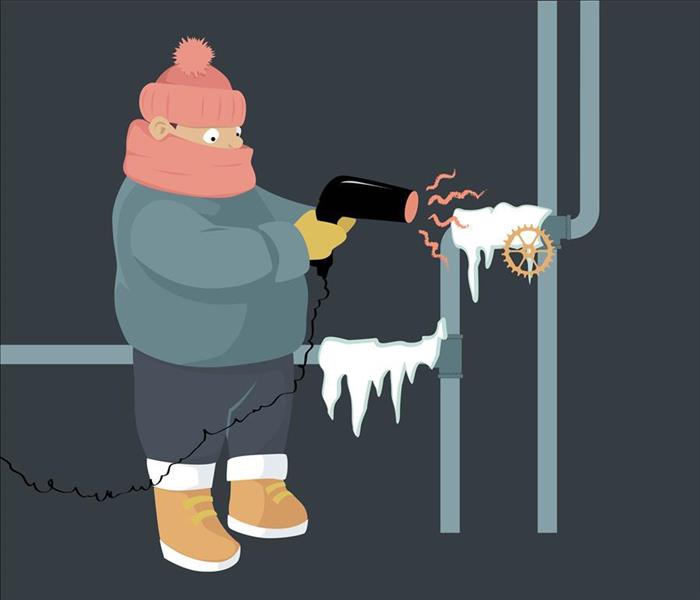 Frozen pipes in Colorado Springs, CO.
Frozen pipes in Colorado Springs, CO.
As winter blankets the picturesque city of Colorado Springs with a snowy embrace, homeowners need to prepare for the challenges that come with freezing temperatures. One of the most vulnerable aspects of your home during winter is its plumbing system. Frozen pipes can lead to costly repairs and significant inconvenience. In this blog, we'll explore essential tips to protect residential pipes from freezing during the winter season in Colorado Springs.
Tips To Protect Pipes From Freezing
Understanding the Risks:
Colorado Springs is known for its cold winters, and temperatures often plummet below freezing. When water in pipes freezes, it expands, creating pressure that can cause pipes to burst. This can lead to water damage, costly repairs, and the inconvenience of being without water during freezing temperatures. Understanding these risks is the first step in proactively protecting your home's plumbing.
- Insulate Exposed Pipes:
One of the most effective ways to prevent pipes from freezing is to insulate them. Identify exposed pipes, especially those in unheated areas like basements, crawl spaces, and attics. Insulating these pipes with foam or fiberglass sleeves provides a barrier against the cold, reducing the risk of freezing. Pay special attention to pipes near exterior walls and windows, as they are more susceptible to the cold.
- Seal Drafts and Air Leaks:
Cold drafts can contribute significantly to freezing pipes. Conduct a thorough inspection of your home for drafts and air leaks, paying attention to areas around windows, doors, and any openings in the walls. Seal these gaps with weather stripping or caulk to keep cold air out and maintain a warmer environment around your pipes.
- Maintain Consistent Indoor Temperatures:
Keeping your home consistently heated is crucial in preventing pipes from freezing. Set your thermostat to a temperature that ensures a warm environment throughout the day and night, even when you are away. While it may be tempting to lower the thermostat to save on energy costs, the potential expenses and inconveniences caused by frozen pipes outweigh the short-term savings.
- Allow Faucets to Drip:
In extremely cold weather, allowing faucets to drip slowly can help prevent pipes from freezing. The continuous flow of water, even at a minimal rate, reduces the likelihood of water freezing within the pipes. Focus on faucets connected to exterior walls and those located in unheated areas. While this method may increase water usage slightly, the cost is minimal compared to the potential expenses associated with frozen pipes.
- Disconnect and Drain Outdoor Hoses:
Don't forget about your outdoor plumbing components. Disconnect and drain hoses, and shut off the water supply to outdoor faucets. Leaving water in outdoor hoses and pipes can lead to freezing, expanding, and potentially causing damage. Storing hoses indoors during the winter is also a good practice.
- Install Pipe Heating Cable:
For particularly vulnerable areas or pipes that are more prone to freezing, consider installing pipe heating cable. This electrical heating element wraps around pipes, providing consistent warmth to prevent freezing. Pipe heating cable is a cost-effective solution for added protection in areas where insulation alone may not be sufficient.
- Insulate the Water Heater:
Insulating your water heater can also contribute to energy efficiency and help maintain warmer water temperatures. A water heater blanket, made of fiberglass or other insulating materials, can be wrapped around the water heater to reduce heat loss. This ensures that your water heater doesn't have to work as hard to maintain a desired temperature, ultimately saving energy and reducing the risk of frozen pipes.
- Be Prepared for Extended Absences:
If you plan to be away from your home during the winter months, take extra precautions to protect your pipes. Set the thermostat to a temperature that will prevent freezing, even in your absence. Ask a neighbor or a friend to check on your home periodically and address any issues that may arise. Consider shutting off the main water supply and draining the pipes if you'll be away for an extended period.
As winter settles in Colorado Springs, CO, safeguarding your residential pipes from freezing is a proactive measure that can save you from costly repairs and the inconvenience of water damage. By insulating pipes, sealing drafts, maintaining consistent indoor temperatures, and implementing other preventive measures, you can enjoy a cozy winter without worrying about the potential hazards of frozen pipes. Taking these steps will not only protect your home but also ensure that you and your family stay warm and comfortable throughout the winter season.
Winter Wonderland: A Comprehensive Guide to Preparing Your Home for the Chills in Colorado Springs, CO
11/9/2023 (Permalink)
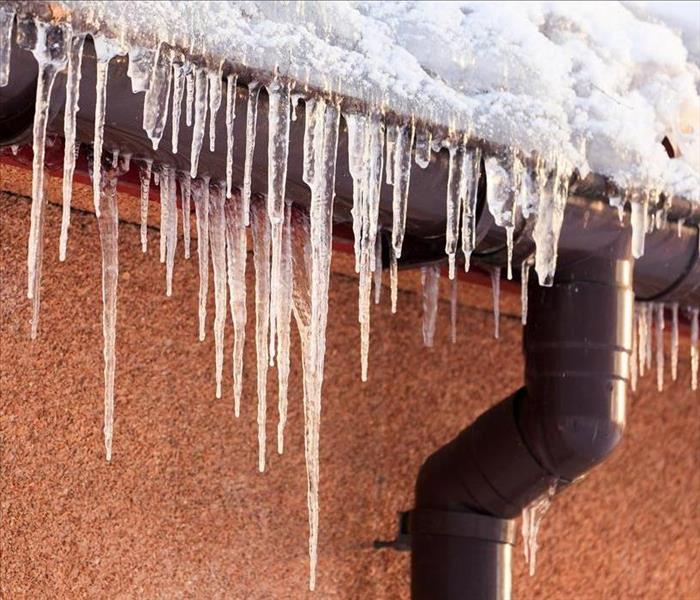 Clean out your gutters to ensure proper drainage and to avoid damage to your Colorado Springs, CO, home.
Clean out your gutters to ensure proper drainage and to avoid damage to your Colorado Springs, CO, home.
As the crisp autumn air settles in and the leaves transform into a vibrant tapestry of reds and golds, it's a subtle reminder that winter is just around the corner. In Colorado Springs, CO, where winter brings its own unique set of challenges, it's crucial to fortify your home against the impending cold. Join me as we explore essential tips and tricks to prepare your abode for the winter wonderland that awaits.
5 Tips To Prepare Your Home For Winter
Inspect and Weatherproof Your Home: Start by examining your home's exterior for any cracks, gaps, or leaks that could allow cold air and moisture to seep in. Use weatherstripping, caulk, and insulation to seal these openings, ensuring your home remains warm and energy-efficient.
Service Your Heating System: Before the temperature plummets, schedule a professional inspection and maintenance for your heating system. Clean or replace filters, check for any malfunctions, and ensure your furnace or heating unit is in top-notch condition to keep your home cozy throughout the season.
Winterize Your Plumbing: Frozen pipes are a common woe during winter. To prevent this, insulate exposed pipes and disconnect garden hoses. Consider installing heat tape for added protection. Additionally, know the location of your water shut-off valve in case of emergencies.
Clean Your Gutters: Autumn leaves can accumulate in your gutters, causing blockages that lead to ice dams. Clean out your gutters and downspouts to ensure proper drainage. This simple step can prevent water damage to your roof and interior.
Trim Trees and Secure Outdoor Furniture: Heavy snowfall can lead to fallen branches and potential damage. Trim any overhanging branches to protect your home and secure outdoor furniture, grills, and other items that could be affected by winter storms.
Stock Up on Winter Essentials: Be prepared for winter storms by stocking up on essentials such as rock salt, sand, and snow removal equipment. Keep a supply of batteries, flashlights, and non-perishable food items in case of power outages.
Check Your Home Insurance: Review your home insurance policy to ensure you have adequate coverage for winter-related damages. Consider adding coverage for specific winter risks, such as damage caused by heavy snow or ice.
Create an Emergency Kit: Prepare for the unexpected by assembling an emergency kit. Include items like blankets, warm clothing, a first aid kit, and necessary medications. Having a well-stocked kit can provide peace of mind during severe winter weather.
As winter approaches, taking proactive steps to prepare your home for the cold can save you from potential headaches and costly repairs. By following these tips, you'll not only keep your home cozy and safe but also have the peace of mind to enjoy the beauty of winter in Colorado Springs. Embrace the season with confidence, knowing that you've fortified your home against the chill of the Rockies.
Mold Prevention After Flooding
8/18/2023 (Permalink)
 Mold growth in Colorado Springs, CO.
Mold growth in Colorado Springs, CO.
If a heavy storm floods your home in Colorado Springs, CO, you want to call water damage specialists right away. Delaying remediation can lead not only to further saturation and subsequent damage but also to secondary issues such as mold growth. To keep rampant fungus from invading your home, you must have water damage repaired as soon as possible.
3 Steps For Mold Prevention After Flooding
1. Water Removal
Getting rid of excess water after a flooding event entails more than just pumping the standing water out of your living room. There are many places unwanted moisture can hide:
- In crawl spaces
- Behind walls
2. Under carpets or tiles
Mitigation experts know exactly where to look to dry your home and prevent secondary damage. They understand each step they need to follow to head off secondary damage at the pass.
Fast Remediation
Mold growth can occur within as little as 24 hours after a flood. Mold feeds on moisture and bacteria, and that's exactly what constitutes the floodwater that invades your home. If you hesitate to call the professionals or try to deal with the problem on your own, you may end up costing yourself a lot of money in the long run.
3. Thorough Cleanup
Even if you do call for water damage repair as soon as the storm passes, widespread destruction throughout your area can present a challenge to timely remediation from local services. If mold removal has to be added to the list of services you need for your home to be restored, it's imperative that the cleanup job is thorough. Mitigation professionals know that they must do more than wipe down the surfaces where mold is showing. They may have to tear out and replace porous materials that the fungus infiltrates to keep it from coming back.
Getting rid of the water in your home after a flood in a timely manner solves more than one problem. It gets your home back to normal faster and prevents further complications such as mold growth.
What You Should Know About Cleaning and Repairing Drywall
7/20/2022 (Permalink)
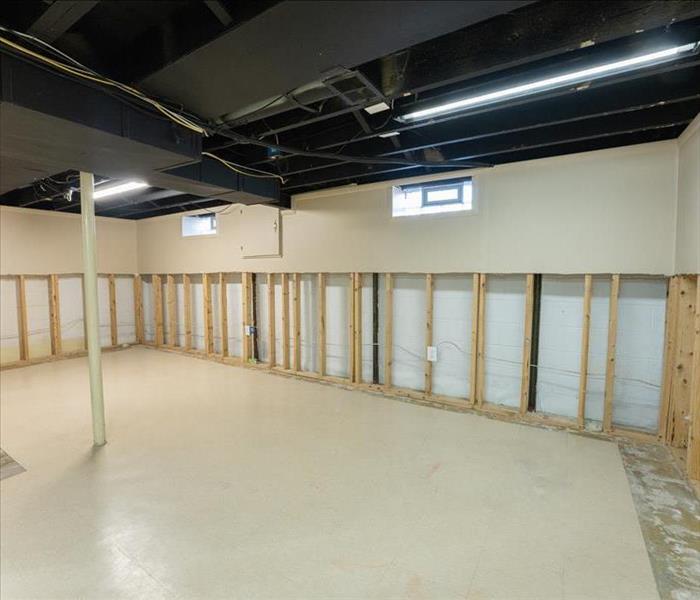 Damaged drywall removed after suffering water damage.
Damaged drywall removed after suffering water damage.
Water damage in your home is a problem that needs to be handled as quickly as possible. Water from flooding due to rising groundwater, sewage backup, and weather events is considered to be black water and as such contains contamination, requiring the intervention of a professional damage restoration company. Untreated damage can lead to the growth and spread of mold. If you ever suffer damage from floods at your home in Black Forest, CO, drying your interiors is a big part of remediation, including drywall repair and cleanup.
Drywall Repair and Cleanup
Removing Drywall After Flooding
Water-soaked drywall cannot be dried and reused, so it must be removed. Water wicks upward in drywall, so it’s generally recommended to tear out a portion of the wall as part of the remediation plan. This is known as a flood cut and it should be at least 12 inches above the flood line. The removal process includes these steps:
- Mark a straight line for the flood cut: Use a chalk line to determine the limit of drywall removal. It should be at least one foot from the flood line.
- Cut along the line with a utility knife: Using a knife, score through the drywall along the length of the flood cut. Do not cut fully through the drywall. Cut ½ to ¾ of the way through.
- Loosen and remove drywall: Using a hammer, make a small hole in the part of the drywall to be removed. Gently separate the drywall from the studs, using the hole as a handle.
- Tear out wet insulation: After removing the drywall, remove any wet insulation. Because insulation can be damper than it feels, it may be worth taking out all of it.
- Use fans to dry out behind the walls: Let your fans run for several hours to improve the airflow behind the wall and facilitate moisture removal.
Taking the Appropriate Measures
Water damage from flooding can also lead to electrical problems. Shut off electricity to affected rooms prior to removing drywall and insulation. The last thing you want to do is create an electrical hazard or cause additional damage that requires extra repair and cleanup. Professional water cleanup providers know how to safely remove drywall and other damaged items throughout your home. If you have to file a claim, your insurance company will prefer working with professionals to restore the damaged areas to preloss conditions.
Understanding the Value of a Full Remediation
Major water damage can also compromise other parts of your home, including floors, ceilings, and other structural elements. The professionals don’t just remove soaked items. They also repair and rebuild your home as necessary, minimizing the cost and time it takes to restore your property. The pros also know how to check for mold and prevent the spread of it to other parts of the house.
While you never want to experience flooding in your home in Black Forest, CO, it’s important to reach out to the pros should it occur. The faster you can remove and dry soaked drywall and other items, the better. Partial removal of the drywall may be all you need to do, but it should be at least 12 inches above the flood levels in your home.
Why You Should Not Drive Down Flooded Roads
7/18/2022 (Permalink)
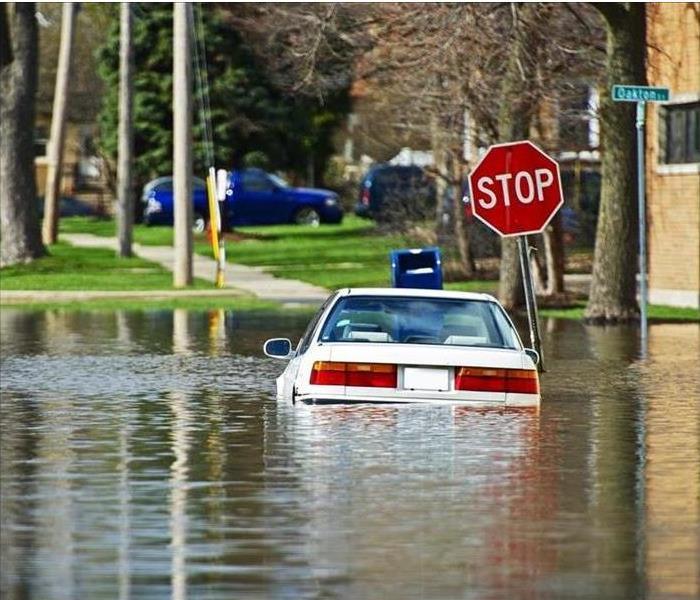 Flooded streets can damage your car.
Flooded streets can damage your car.
While many people worry about flooding to their homes, they do not think about what can happen if they drive during a flood. A flooded street is just as dangerous as rising water inside a home and requires just as much storm remediation. Here are a few reasons why you should not travel during a flood.
3 Reasons Why Should Not Travel in Flooded Roads
- You Are in the Way
During a flood situation, crews in Colorado Springs, CO need to be able to do their jobs. These crews may be:
- Restoring electricity
- Rescuing those in need
- Clearing blocked roads
- Dealing with leaks and spills
- Attempting to mitigate the rising waters
These crews must be able to perform their jobs without interference from motorists. A flooded street is even more dangerous to work crews if you are attempting to drive on it.
- It Can Damage Your Car
Not only can the water from flooded roads seep into your car through cracks in the doors, even a small amount of water can severely damage your engine. Most cars have an air intake on the bottom of an engine. Normally this isn't a problem because there is not enough water that enters the engine to hurt it. A car's engine can pull in large amounts of water during a flood, causing catastrophic engine failure. This damage cannot be corrected without replacing the engine.
- You Risk Losing Control
A car can start to slide in just an inch of water. During a storm, it is important to pay attention to your auto manufacturer or insurance company's travel tips. They understand the risks that water poses and can help you if you absolutely have to travel. One of these tips is usually, do not drive unless it is necessary.
Not only is driving down a flooded street dangerous to you personally, but it is also dangerous to work crews and can destroy your car. It is always best to stay safe and off the streets during a flood.
How FEMA Can Provide Assistance Following a Storm
5/26/2022 (Permalink)
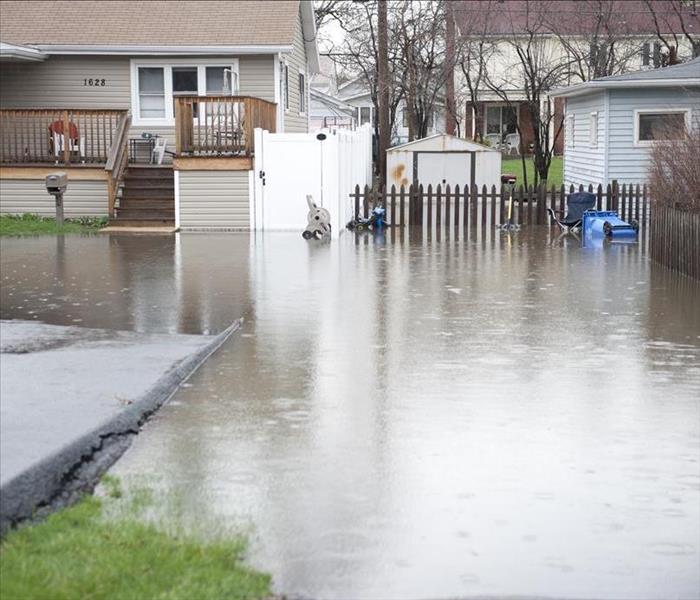 Avoid further Storm Damage in your Property. Trust FEMA Specialists.
Avoid further Storm Damage in your Property. Trust FEMA Specialists.
As its name implies, the Federal Emergency Management Agency, or FEMA, aids Americans who are struggling after a disaster. If a storm floods your Black Forest, CO, home, the agency can help you in several ways.
Types of Assistance the FEMA Provides After a Flood
1. Temporary Housing
Depending on the extent of the damage, you may not be able to stay in your home immediately after the storm. You may instead have to rent a hotel room, apartment or Airbnb. The Federal Emergency Management Agency can assist you with these rent payments.
Federal government funds can also reimburse you for other lodging expenses, such as taxes charged by a hotel owner. You can only obtain this money if your current home is inaccessible, unlivable or affected by an extended storm-related power outage. Transportation and food costs are not included.
2. Home Repairs
Federal money can also help you pay for storm damage restoration. However, the government will not cover the costs of repairing and replacing every broken item. The funds can only be used for basic repairs that will make your house functional, clean and safe.
For instance, the funds will not cover floor coverings such as carpet or tile. The money will not pay for replacement drapes or blinds, either. Yet you can use the money to fix damaged subfloors and broken windows.
Vital home appliances, including stoves and refrigerators, are covered by government assistance. The federal money also may pay for repairs to damaged HVAC and utility systems. However, you will need to use either your insurance money or your personal funds to replace damaged non-essential items, including home-theater systems and dishwashers.
3. Other Needs
The government additionally provides funding for other essential expenses that result from the disaster. For instance, FEMA money can help you pay for a moving company that can transfer your belongings from your home into your new temporary residence. If you decide to put certain items in a storage facility during the restoration, the government funds may pay for this expense, as well.
The storm might also force you to purchase certain items that you would not otherwise buy, such as a chainsaw. You or a loved one may also need to replace a damaged insulin pump or another medical device. Government money can be used for these costs.
Applying for Assistance
If your house has been affected by flooding, you can apply for government assistance online. You can also call the agency’s toll-free number if you do not have internet access.
Keep in mind that the Federal Emergency Management Agency programs do not replace insurance. You should thus first contact your insurance provider and see how much coverage you have. If you do not have any insurance, or if your provider will only pay for some of your damages, you can then seek aid from the government.
Dealing with the aftermath of a storm is especially difficult if your home is uninsured or underinsured. Instead of dipping into your savings to pay for remediation, contact FEMA. Whether your home has wind or flood damage from a storm, the agency can assist you.
What Does My Flood Zone Mean?
2/22/2022 (Permalink)
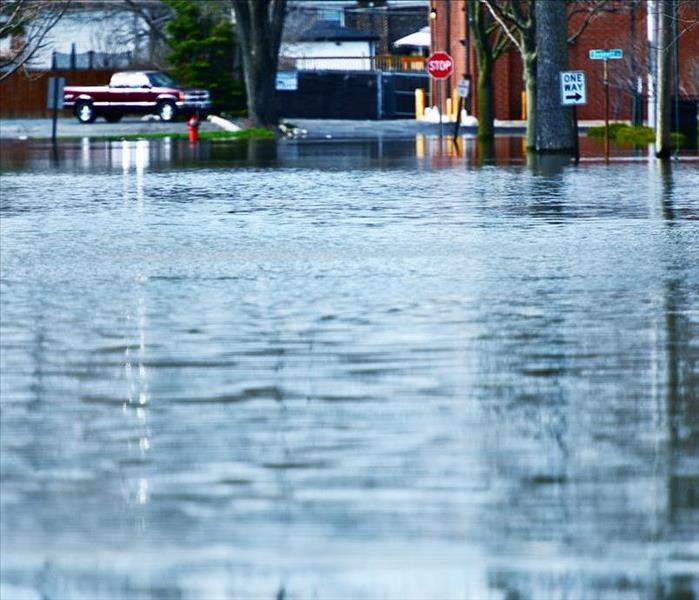 Learn more about Flood Zones following these tips. If you have more questions, just contact us.
Learn more about Flood Zones following these tips. If you have more questions, just contact us.
No matter where you live, there is some level of flood risk. Some areas have a higher flood risk than others. A flood zone is an indication of the level of flood risk in a geographic area.
What You Should Know About Your Flood Zone
If you aren't sure which zone you are in, you can find out by checking your community's flood map. The flood map includes information on your community's zone, base flood elevation and floodplain boundaries. These maps are used to determine your flood insurance requirements and how much flood insurance costs in your area.
What Are the Different Flood Zones?
Zones B, C and X are moderate to low-risk zones. These areas do not have as much risk for flooding as high-risk zones, but there is still a risk. About a third of all federal assistance claims are for properties in these zones.
Zones A and V are high-risk zones. These are the regions that have the greatest risk of experiencing a flood because of a storm. People who live in these zones and have federally backed mortgages are required to buy flood insurance.
Do I Need Flood Insurance If I Have Homeowners Insurance?
Most homeowners' policies only cover flood damage from a sudden and accidental discharge of water, such as a broken pipe. Flood damage that happens because of storm surges, overflowing rivers and streams or flash flooding is usually not covered.
Do I Need Flood Insurance If My Community Has Never Flooded?
Flash floods can happen almost anywhere. Storm drains that are clogged with leaves, melting snow, broken water mains and construction projects can all cause a flood in areas that normally do not experience it.
Do I Need Flood Insurance If I Do Not Live in a High-Risk Zone?
Floods can happen in any flood zone. More than 40% of National Flood Insurance Program claims are for properties located outside of high-risk zones.
Will Federal Disaster Assistance Cover My Flood Damage?
Federal disaster assistance is only available after the President has made a disaster declaration. This only happens in very severe flood disasters. Most flood events do not qualify. Additionally, most assistance is loans that must be paid back.
The amount of assistance most property owners receive is intended to assist homeowners with getting back on their feet but usually does not cover the full restoration cost of a flooded home.
The proceeds from flood insurance are intended to restore your property to its preloss condition and do not have to be paid back. Without flood insurance, you may have to pay expenses, such as the cost for flood remediation services in Colorado Springs, CO, yourself.
Do I Need Flood Insurance If I Rent?
Your landlord probably has flood insurance on the building you live in, but if you want protection for your possessions, you need to purchase a contents-only flood policy.
No matter which flood zone you live in, it is a good idea to understand your flood risk. Knowing your risk helps you make appropriate decisions about insurance coverage and other risk mitigation strategies.
Content Cleaning: What To Keep and What To Toss
1/19/2022 (Permalink)
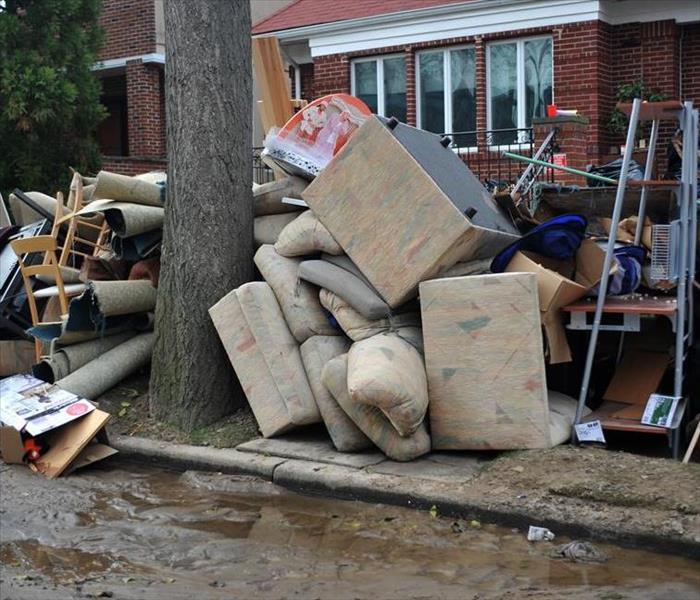 Know better what to Keep and what to Toss if a Storm happens in your Colorado Springs, CO, house.
Know better what to Keep and what to Toss if a Storm happens in your Colorado Springs, CO, house.
The recovery process after a significant storm can be daunting, especially as you consider all of the steps involved in content cleaning. The good news is that Colorado Springs, CO, storm and water damage cleaning and recovery teams can help you through the process with professional equipment and techniques:
- Dry and foam cleaners
- Immersion cleaning equipment
- Spray and wipe supplies
The more you know about how to respond to a flood, the better you'll be prepared to avoid problematic damage and expensive repairs.
The Ins and Outs of Content Cleaning
One of the first areas of concern after your home is affected by flooding, especially black water, is content cleaning. This refers to all of the contents in your home that can be salvaged. Once your home has been inspected by the appropriate professionals, you can begin sorting belongings into a pile of things that must be thrown out and an assortment of items that can be cleaned and repaired.
Things To Throw Away
Some items absorb contaminants or leach toxins as they become waterlogged. These porous items should be thrown out:
- Furniture left in water for multiple days
- Carpets that come apart in your hand
- Furnishings with running dye, especially blue
- Items that smell bad or have evidence of mildew
- Swollen or warped wood pieces.
Other items, such as mattresses and books, are usually cheaper to replace than to try to clean and repair. For your safety and your family's safety, always throw out food that has come into contact with water (including pet food) and medications that have been exposed to the water.
Things You Can Salvage
Although any type of water can cause serious damage to your property, some water is dirty enough that you should throw out anything that has been affected. That being said, if your flood consisted of clean water, there are many things you can keep:
Appliances
Electronics
Toys
Important paperwork
Family heirlooms
Photographs
If Colorado Springs, CO, water damage cleanup and mitigation crews arrive quickly to clear away water and dry your home, it is possible for you to save carpets and furniture. If you own something that is expensive or has a lot of sentimental value, reach out to specialists in restoration and repair for help.
Areas of Concern
While you're focused on moving furnishings and belongings out of your home, there are some things you should be aware of:
Floors and walls could have been weakened; be careful where you step or lean.
Porous materials may become moldy. If there is any evidence of mold contamination, these items should be thrown out.
Floodwater may carry hazardous contaminants; wear protective clothing while you work.
When handling appliances or fragile belongings, further damage could occur. Be very careful when lifting and transporting belongings.
Moisture and mold spores can be spread from the affected areas of your home into areas that were initially unaffected. Take care to seal off those separate areas to prevent causing new damage.
You may be anxious to get into your home and begin the cleanup process after flooding. Your first concern, however, should be safety. Wait until you have permission from local authorities before you begin working on content cleaning and other recovery efforts.
How To Prepare for a Winter Storm
1/14/2022 (Permalink)
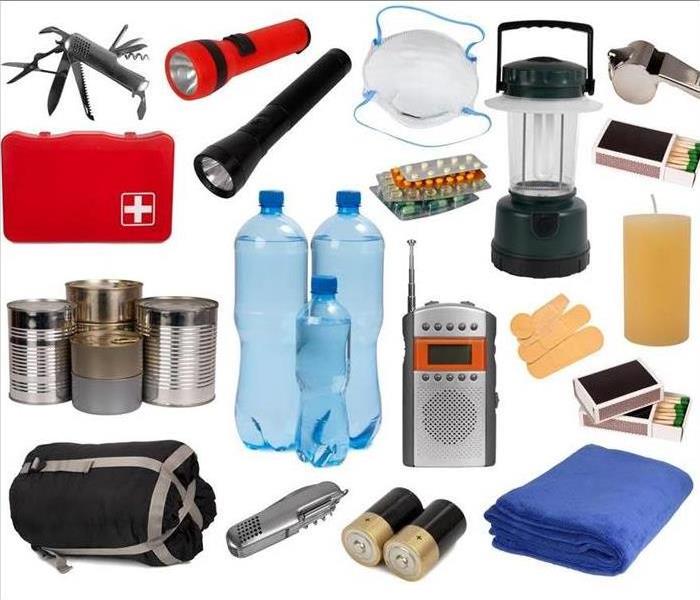 Keep an emergency kit stocked with three days' worth of essentials
Keep an emergency kit stocked with three days' worth of essentials
From frozen pipes to black ice and flood water, extreme winter weather in Colorado Springs, CO, can wreak havoc on your home. Here are four ways you can prepare your family for a winter storm.
Tips For Winter Storm
- Draft Communication and Evacuation Plans
All members of your household should know how to get in touch with each other and where to go in the event of a winter storm. Ideally, your communication plans should address a variety of specifics scenarios. Similarly, your evacuation plan should incorporate not just the safest route to your local emergency shelter, but also a viable alternative. If local authorities tell you that you should get out, get out.
- Winterize Your Car
Fleeing a blizzard is not the time to have your car refuse to start or run out of gas. Have your mechanic perform a thorough check before winter hits. Make sure your winter tires have good treads. Keep your gas tank full, and stash winter supplies in your trunk, such as a windshield scraper, matches, a first-aid kit, blankets, an emergency signal, and sand or kitty litter for creating traction if you get stuck.
- Protect Your Pipes
Frozen pipes can burst and lead to a flooded building. To avoid needing the services of a water damage recovery company, you can help prevent broken pipes and flood water by a variety of means:
- Leave cabinets under sinks open to allow warm air in
- Insulate pipes with heat tape, pipe sleeves or — in a pinch — newspaper
- Close interior valves that provide water to outside hoses
- Prepare Your Home
Keep an emergency kit stocked with three days' worth of essentials:
- Water
- Nonperishable food
- First-aid supplies
- Medications
- Flashlight
- Batteries
- Radio
- Pet food and supplies
Bring pets inside, and make sure any alternative heat sources such as space heaters, generators, fireplaces, and stoves are clean, functioning properly, and well-stocked with fuel or materials.
Winter is inevitable. Severe winter storms are not. Expecting the unexpected can help you ride out a winter storm safely and with minimal flood water, frozen infrastructure, or other damage to your home.
Why Cleaning Flood Damage Is Different
10/28/2021 (Permalink)
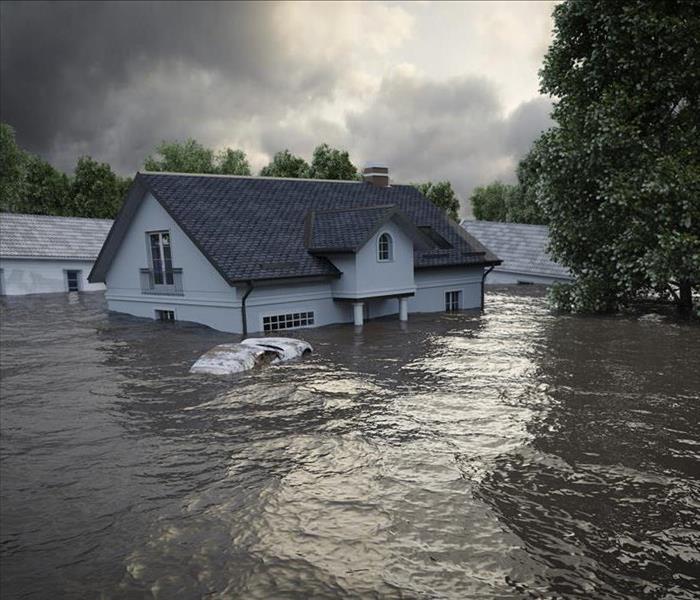 Use the correct method of cleaning your home after a flood in your Black Forest, CO home.
Use the correct method of cleaning your home after a flood in your Black Forest, CO home.
There are many different types of water damage, ranging from a leaking supply line to flooding from a major storm. The process of cleaning up the water varies depending on what the cause of the water damage is.
What Makes Flood Damage Different?
The primary difference between cleaning up flood damage and other types of water damage is how the water is classified. Water is classified in one of three ways:
1. Category 1
Category 1 water is also called clean water. It is water from an uncontaminated source, such as a broken pipe or supply line. Overflow from a sink, tub, or toilet that contains no chemicals or biological contaminants may also be category 1.
2. Category 2
Category 2 water is called gray water. It is water that may contain chemicals or biological agents but is not considered grossly unsanitary. Examples include water from a washing machine, rinse water from a bath or shower, and water from a toilet that contains urine, but not feces. It can also be Category 1 water that has been standing for too long.
3. Category 3
Category 3 water is water that is grossly contaminated. Examples include sewage backups, water from flooding, and Category 2 water that has been standing too long.
Different Cleanup Methods Are Required
Different categories of water require different cleanup methods. Category 1 water generally does not have any special requirements for cleanup. Category 2 water may require the use of protective gear. Category 3 water is not safe to handle without the right training, equipment, and safety gear. Additionally, surfaces that come in contact with Category 3 water need to be both cleaned and disinfected. Because of the safety issues, it is recommended that homeowners utilize a storm damage restoration company in Black Forest, CO, to do flood cleanup, rather than attempt it themselves.
The Damage Is Usually More Extensive
In addition to the risks involved with handling contaminated water, damage from floods is usually more extensive than damage from a household situation such as a broken pipe. There may be fallen trees, downed power lines, and other obstacles. Industrial equipment, such as submersible pumps, fans, and dehumidifiers may be needed to dry out the property. Because flood events are usually widespread, it may be difficult for homeowners to find rental equipment to use.
Mold May be a Problem
Extensive flood damage also poses a mold risk. While drying out the home as soon as possible can reduce the chance of mold occurring, it may not be safe to re-enter the home until after the 24 to 72 hour period when mold may begin to grow. Homeowners attempting to do cleanup themselves may not get the home dried out fast enough to avoid mold problems. Additionally, a restoration company can address any signs of mold issues already occurring early in the process to prevent mold from spreading.
Small amounts of water from broken pipes or leaking appliances may be able to be cleaned up by homeowners. However, flooding often creates conditions that are difficult for homeowners to contend with without assistance.
6 Home Damage Mitigation Tips
8/21/2021 (Permalink)
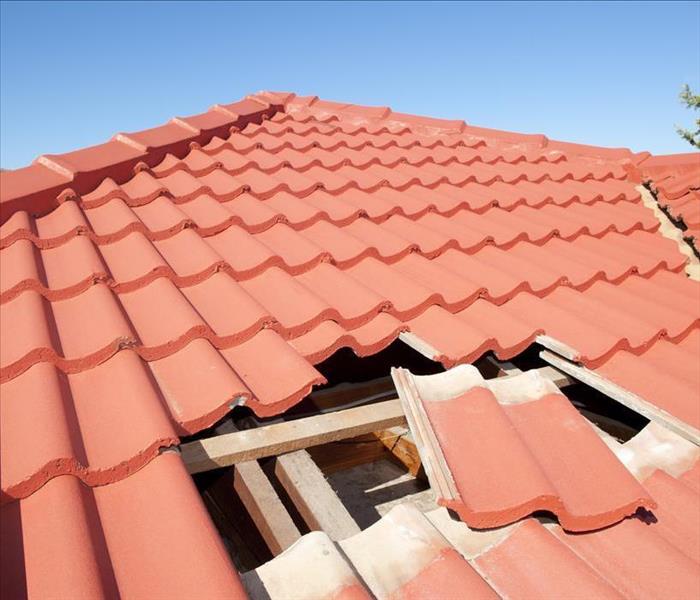 A storm can cause severe damage to your home in Black Forest, CO.
A storm can cause severe damage to your home in Black Forest, CO.
One of the functions of your roof is to protect your home from wind, water, and falling objects. When you have roof damage, that protection is often weakened and without mitigation can lead to additional damage to your home.
These mitigation tips can help you avoid additional damage.
1. Cover Broken or Cracked Windows and Skylights
Damage from hail, tree limbs, or debris can create cracks or holes in windows and skylights. This can cause leaks if it rains before you can have permanent repairs made. Cover damaged windows and skylights with plastic to prevent additional damage while you wait for repairs.
2. Use a Tarp on Your Damaged Roof
If your roof has wind damage or has begun to leak after a storm, cover the damaged area with a tarp or call a contractor in Black Forest, CO, to do it for you. If you can not immediately place a tarp, put buckets under the leaking areas to reduce the amount of water damage in your home. If you have substantial water damage, consider contacting a water restoration company to dry out your property. This will reduce the chance that the excess moisture will lead to mold growth.
3. Remove Fallen Trees
Heavy rains can saturate the ground around your home and cause trees to fall on your house. If this happens to you, contact a tree company to remove the fallen tree as soon as possible and place a tarp on any areas with roof damage. You can prevent future damage by keeping trees near your home trimmed and removing any trees that are dead or unhealthy.
4. Repair Damaged Shingles
Loose, missing or damaged shingles can make your roof more vulnerable to damage from wind, rain, and snow. Have your roof inspected regularly and any time you have had a major storm event. Repair any issues with your roof before the next storm occurs.
5. Replace Your Roof When Needed
A roof with asphalt shingles will last between 15 to 30 years. Wood shingle roofs need to be replaced after 20 to 25 years. Rubber roofs can last 30 to 50 years and metal roofs will last 50 to 75 years. Replacing your roof when needed helps to protect the interior of your home from damage. Regularly maintaining your roof and keeping it free from debris can prolong its life.
6. Maintain Your Siding
Damaged siding is another frequent entry point for wind and water. Vinyl siding can last between 30 and 40 years. Other types of siding may need to be replaced more frequently. If your siding is damaged during a storm or other event, use a tarp to cover the damaged area until it can be replaced. If you have wood siding, keep it painted and regularly inspect it for signs of rot.
If you have roof damage, it is important to take steps to ensure that wind, rain, or other elements do not cause additional damage to your property while you wait for permanent repairs. If you have insurance, your insurance may cover the cost of damage mitigation efforts.
How FEMA Can Help You
7/29/2021 (Permalink)
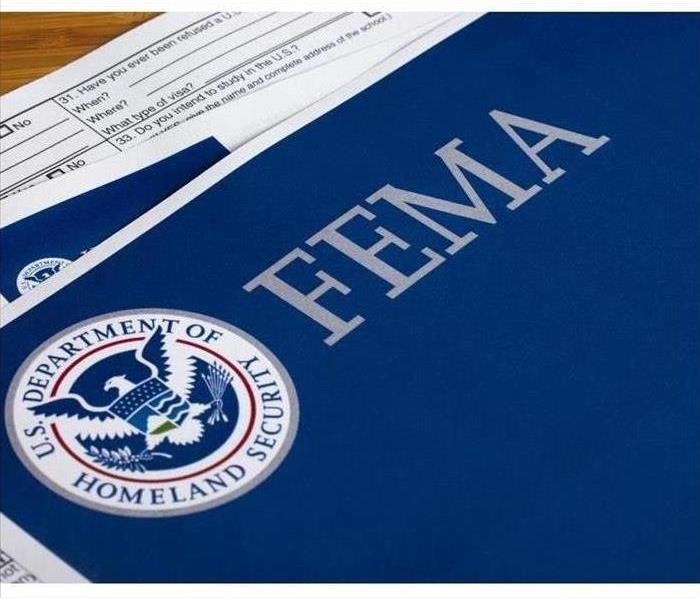 Thankfully, you can receive assistance from an organization called the Federal Emergency Management Agency, or FEMA.
Thankfully, you can receive assistance from an organization called the Federal Emergency Management Agency, or FEMA.
After a severe storm such as a hurricane or tornado, people often return to find their homes in shambles. There may be a torn-off roof, damage from fallen trees, and wind damage. You may be wondering how to put the pieces back together after a devastating storm in Black Forest, CO. Thankfully, you can receive assistance from an organization called the Federal Emergency Management Agency, or FEMA. You may be unsure of how they can help you or how to apply. Having this information can help you get your life back to normal again, with the help of storm damage repair experts.
How to Apply
You can get assistance by applying online, or you can apply over the phone if you prefer. There is some information you should have handy when applying:
- Your home address (of the damaged home)
- Description of the damage that was incurred due to the storm
- Information on who lives in your house
- Your bank account information
Having this information handy upfront will likely help the application process easier.
Who Does It Help?
FEMA can help those whose homes or property were badly damaged or destroyed by a flood or other storm damage. Even if you have insurance, it can be helpful to have government assistance to help get your home back to normal again.
How Does It Help?
If you are a homeowner, then you might get money to help with repairing the damage from flooding or strong winds. You may also be able to get some money to help replenish household items destroyed, such as furniture or clothing. Those who were injured in the storm may be eligible to have medical costs reimbursed. Finally, for those who don't have a place to stay after their home is damaged, temporary housing assistance can be arranged.
FEMA can be great for helping you get back on your feet again after a severe storm. Be sure to apply as soon as you can, as it might help expedite the process to receive your assistance.
3 Things To Consider About Solar Panels and Storms
7/17/2021 (Permalink)
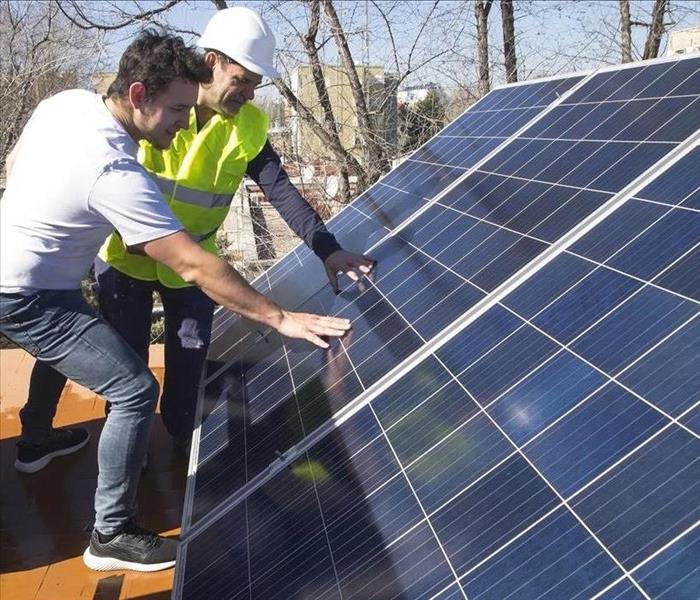 Installing solar panels in your Colorado Spring home, NC, are a great option if it is done by a professional.
Installing solar panels in your Colorado Spring home, NC, are a great option if it is done by a professional.
Many homeowners are moving toward renewable energy sources to make their homes more energy-efficient. Solar panels are quickly growing in popularity, but many people are still reluctant to spend money on panel installation because they worry about panel damage. Fortunately, most of their concerns are unnecessary because modern-day panels are stronger and more durable than past models. While original panels or systems might have required clean-up from a storm restoration service in Colorado Springs, CO, modern-day panels can withstand most storms, but there are a few things you should know.
1. Panels Are Durable, Not Indestructible
Most solar systems, including individual panels, can withstand winds of up to 140 mpg before sustaining any serious panel damage, meaning most systems can withstand a category four hurricane. However, while the panels can sustain such powerful winds, that does not mean they can withstand a hit from all debris hurdling at such speeds.
2. Panel Damage Will Require Professional Repair
Unlike some minor roof damage that can be corrected with a simple patch, panel damage cannot be corrected by just any professional or DIY aficionado. When a storm causes damage to a panel or the solar power system, you will most likely need to call the company that installed your system to inspect it and repair any damage.
3. Panels Require Maintenance Like Any Other
Structure or Appliance
Installing a solar power system is not something you can set up and forget about. Sure, the system essentially runs itself, but just like any other structure or appliance on or in your property, routine maintenance is vital to optimal performance.
While panel damage is possible with a solar power system, it should not keep you from benefitting from the energy-efficient upgrade. The panels are stronger than you think, so keep the risks in mind, but do not let them drive the decision. Instead, consult with a solar power installer and weigh the pros and cons.
Wildfires and Flooding: How To Protect Your Home
5/28/2021 (Permalink)
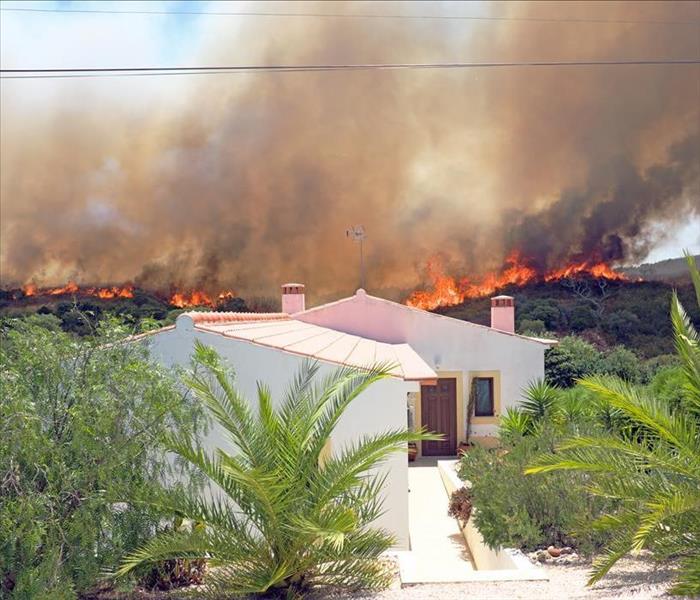 Wildfires can increase the risk of flooding.
Wildfires can increase the risk of flooding.
Wildfire damage affects Colorado Springs, CO, residents in many ways. One of the most significant causes of further damage is the increased risk of flooding:
- The charred ground doesn't absorb water efficiently.
- Instead of soaking into the ground, rainwater gathers and runs, picking up soil and debris as it floods into communities.
- After-fire flooding can occur for up to five years after the wildfire.
Before wildfire affects your home, learn how the FEMA NFIP, or Federal Emergency Management Agency's National Flood Insurance Program, can help keep your home safe.
Insurance Coverage
If your home survives the flames of a wildfire, your next main concern should be flooding damage. Unfortunately, many general homeowners' policies don't cover this type of damage, and additional policies may be expensive. The FEMA NFIP is an affordable option that may provide you with the funds necessary to hire fire and flood damage cleanup and restoration professionals.
Fire and Flood Damage Prevention
In addition to purchasing necessary insurance, you can prepare your family and home against damage from fires and flooding:
- Clear brush away from your home. Keep trees, bushes, and other combustible items at least five feet away from the home.
- Remove dead plants, branches, leaves, and clutter away from your yard.
- Don't store firewood next to your home.
- Keep downspouts and gutters clean to allow for water flow.
- Improve the grade on your property, so water flows away from your home.
- Create a landscape that allows water to be absorbed.
You can also reach out to your insurance provider for other steps that reduce the risk of flooding and other fire damage. With these steps complete, spend some time backing up any vital paperwork, such as the deed to your home and family documents. It's also a good idea to create a family emergency plan for evacuation, communication, and meeting places.
Peace of Mind
While you can't anticipate all the dangers that wildfire brings to your community, your access to FEMA NFIP can help you decrease the fallout. Any steps you take to prepare for wildfires or flooding can help you respond calmly and confidently in an emergency.
3 Steps To Take After a Crawlspace Flood
2/24/2021 (Permalink)
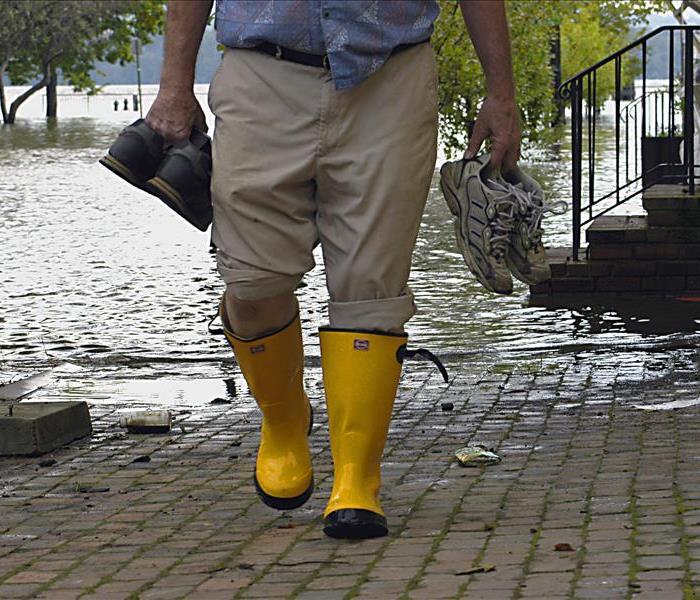 Use proper clothing to clean up a flooded crawlspace
Use proper clothing to clean up a flooded crawlspace
A home flood can cause extensive damage to all of the structures of your home, including the crawlspace. These are three steps you should take after your crawlspace has been exposed to floodwater.
3 Steps to Take After A Crawlspace Has Been Exposed to Floodwater
1. Dry Out Your Crawlspace
The first thing you need to do is dry out your crawlspace. The ground under your home will absorb some moisture, but once the ground becomes saturated the remaining moisture will evaporate into your home. This can result in mold and mildew growth, ductwork damage, sewer line or septic tank ruptures and structural damage. It may be a good idea to contact a restoration company in Colorado Springs, CO, to quickly dry out your crawlspace before additional problems can develop.
2. Prevent Future Floods
Once you have your crawlspace dried out, take steps to prevent a future home flood. Clean and maintain your gutters and make sure the downspouts point away from your crawlspace. Your downspouts should extend at least 10 feet away from your crawlspace. Additionally, your gutters should be kept free of leaves and other debris that can prevent drainage. You may want to consider installing screens on your gutters to prevent debris from accumulating.
3. Flood Proof Your Crawlspace
In addition to directing water away from your home, you can reduce potential storm damage by installing a vapor barrier, drainage system and sump pump. Installing a vapor barrier across the dirt floor under your crawlspace can reduce the amount of moisture that enters your home after a flood. A sump pump and drainage system can reduce the amount of water that accumulates in your crawlspace by directing it away from your home. Additionally, mold-resistant coatings can be applied to your crawlspace area to lower the chance of mold growth.
Water accumulation in your crawlspace from a home flood can lead to additional property damage. Promptly drying out and flood proofing your crawlspace can help you avoid this damage.



 24/7 Emergency Service
24/7 Emergency Service
















